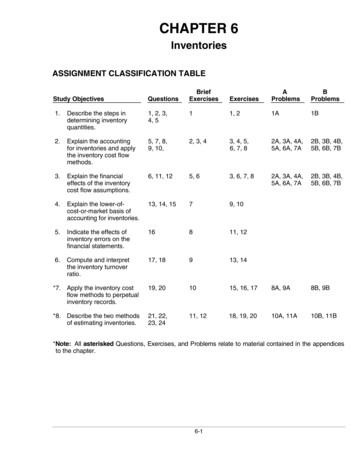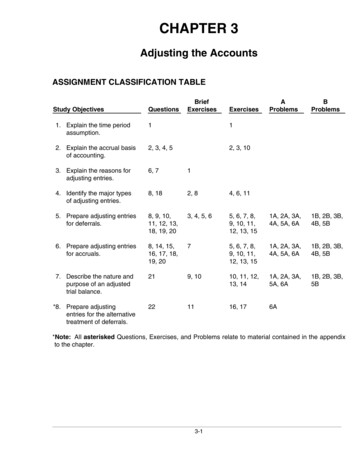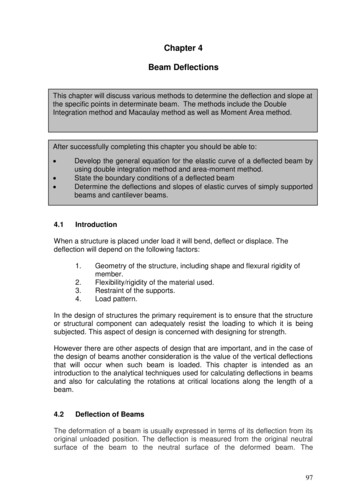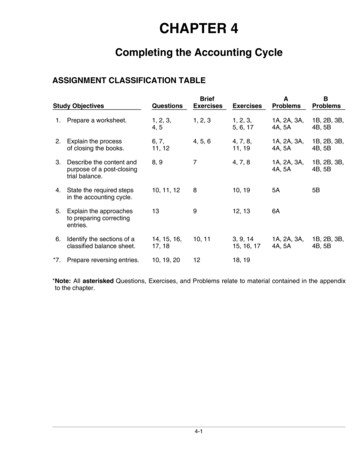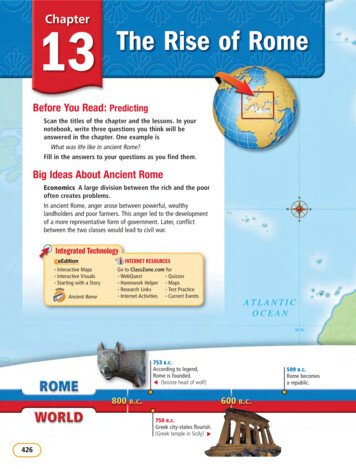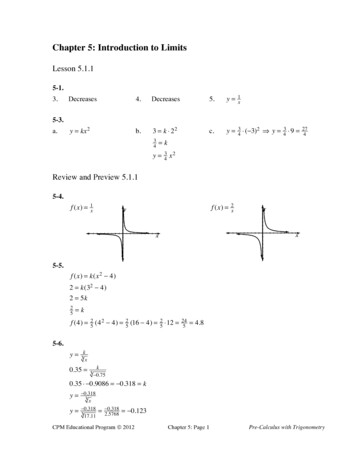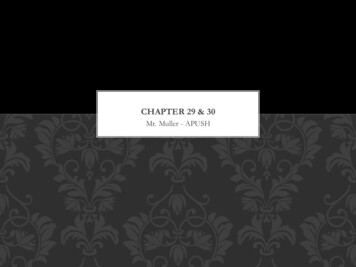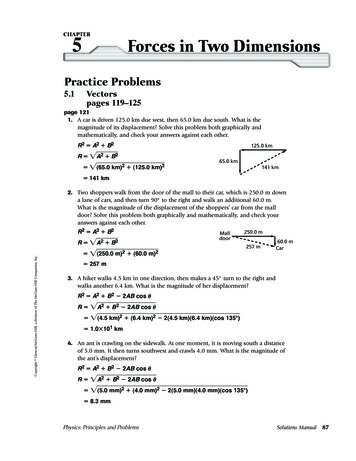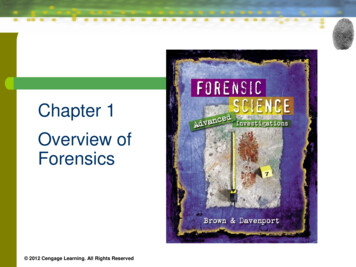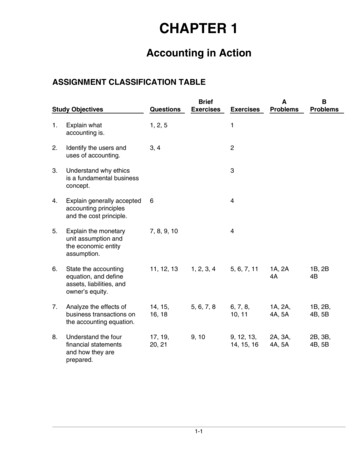
Transcription
CHAPTER 1Accounting in ActionASSIGNMENT CLASSIFICATION TABLEBriefExercisesAProblemsBProblems5, 6, 7, 111A, 2A4A1B, 2B4B5, 6, 7, 86, 7, 8,10, 111A, 2A,4A, 5A1B, 2B,4B, 5B9, 109, 12, 13,14, 15, 162A, 3A,4A, 5A2B, 3B,4B, 5BStudy ObjectivesQuestionsExercises1.Explain whataccounting is.1, 2, 512.Identify the users anduses of accounting.3, 423.Understand why ethicsis a fundamental businessconcept.4.Explain generally acceptedaccounting principlesand the cost principle.645.Explain the monetaryunit assumption andthe economic entityassumption.7, 8, 9, 1046.State the accountingequation, and defineassets, liabilities, andowner’s equity.11, 12, 131, 2, 3, 47.Analyze the effects ofbusiness transactions onthe accounting equation.14, 15,16, 188.Understand the fourfinancial statementsand how they areprepared.17, 19,20, 2131-1
ASSIGNMENT CHARACTERISTICS TABLEProblemNumberDescriptionDifficultyLevelTime Allotted(min.)1AAnalyze transactions and compute net income.Moderate40–502AAnalyze transactions and prepare income statement,owner’s equity statement, and balance sheet.Moderate50–603APrepare income statement, owner’s equity statement, andbalance sheet.Moderate50–604AAnalyze transactions and prepare financial statements.Moderate40–505ADetermine financial statement amounts and prepareowner’s equity statement.Moderate40–501BAnalyze transactions and compute net income.Moderate40–502BAnalyze transactions and prepare income statement,owner’s equity statement, and balance sheet.Moderate50–603BPrepare income statement, owner’s equity statement, andbalance sheet.Moderate50–604BAnalyze transactions and prepare financial statements.Moderate40–505BDetermine financial statement amounts and prepareowner’s equity statement.Moderate40–501-2
1-3Explain the monetary unitassumption and the economicentity assumption.State the accounting equation,and define assets, liabilities, andowner’s equity.5.6.Broadening Your PerspectiveUnderstand the four financialstatements and how they areprepared.Explain generally acceptedaccounting principles and thecost principle.4.8.Understand why ethics is a fundamental business concept.3.Analyze the effects of businesstransactions on the accountingequation.Identify the users and uses ofaccounting.2.7.Explain what accounting is.1.Study -4BP1-5BP1-2A -15E1-16BE1-6BE1-7BE1-8E1-6E1-7AnalysisFinancial ReportingComparative AnalysisExploring the -1AApplicationE1-6E1-7E1-2Q1-5E1-1Exploring the ge ComprehensionSynthesisAll About YouComparative AnalysisDecision Making Acrossthe OrganizationCommunication ActivityEthics CaseEvaluationCorrelation Chart between Bloom’s Taxonomy, Study Objectives and End-of-Chapter Exercises and ProblemsBLOOM’S TAXONOMY TABLE
ANSWERS TO QUESTIONS1.Yes, this is correct. Virtually every organization and person in our society uses accountinginformation. Businesses, investors, creditors, government agencies, and not-for-profit organizationsmust use accounting information to operate effectively.2.Accounting is the process of identifying, recording, and communicating the economic events ofan organization to interested users of the information. The first step of the accounting process istherefore to identify economic events that are relevant to a particular business. Once identifiedand measured, the events are recorded to provide a history of the financial activities of theorganization. Recording consists of keeping a chronological diary of these measured events in anorderly and systematic manner. The information is communicated through the preparation anddistribution of accounting reports, the most common of which are called financial statements.A vital element in the communication process is the accountant’s ability and responsibility toanalyze and interpret the reported information.3.(a) Internal users are those who plan, organize, and run the business and therefore are officersand other decision makers.(b) To assist management, accounting provides internal reports. Examples include financialcomparisons of operating alternatives, projections of income from new sales campaigns,and forecasts of cash needs for the next year.4.(a) Investors (owners) use accounting information to make decisions to buy, hold, or sell stock.(b) Creditors use accounting information to evaluate the risks of granting credit or lending money.5.Bookkeeping usually involves only the recording of economic events and therefore is just one partof the entire accounting process. Accounting, on the other hand, involves the entire process ofidentifying, recording, and communicating economic events.6.Karen Sommers Travel Agency should report the land at 90,000 on its December 31, 2008balance sheet. An important concept that accountants follow is the cost principle. The costprinciple states that assets should be recorded at their cost. Cost has an important advantageover other valuations: it is reliable. Cost can be objectively measured and can be verified.7.The monetary unit assumption requires that only transaction data capable of being expressed interms of money be included in the accounting records. This assumption enables accounting toquantify (measure) economic events.8.The economic entity assumption requires that the activities of the entity be kept separate anddistinct from the activities of its owners and all other economic entities.9.The three basic forms of business organizations are: (1) proprietorship, (2) partnership, and(3) corporation.1-4
Questions Chapter 1 (Continued)10.One of the advantages Maria Gonzalez would enjoy is that ownership of a corporation is represented by transferable shares of stock. This would allow Maria to raise money easily by sellinga part of her ownership in the company. Another advantage is that because holders of the shares(stockholders) enjoy limited liability, they are not personally liable for the debts of the corporateentity. Also, because ownership can be transferred without dissolving the corporation, the corporationenjoys an unlimited life.11.The basic accounting equation is Assets Liabilities Owner’s Equity.12.(a) Assets are resources owned by a business. Liabilities are claims against assets. Put moresimply, liabilities are existing debts and obligations. Owner’s equity is the ownership claimon total assets.(b) Owner’s equity is affected by owner’s investments, drawings, revenues, and expenses.13.The liabilities are: (b) Accounts payable and (g) Salaries payable.14.Yes, a business can enter into a transaction in which only the left side of the accounting equationis affected. An example would be a transaction where an increase in one asset is offset bya decrease in another asset. An increase in the Equipment account which is offset by a decreasein the Cash account is a specific example.15.Business transactions are the economic events of the enterprise recorded by accountantsbecause they affect the basic equation.(a) The death of the owner of the company is not a business transaction as it does not affect thebasic equation.(b) Supplies purchased on account is a business transaction as it affects the basic equation.(c) An employee being fired is not a business transaction as it does not affect the basic equation.(d) A withdrawal of cash from the business is a business transaction as it affects the basic equation.16.(a) Decrease assets and decrease owner’s equity.(b) Increase assets and decrease assets.(c) Increase assets and increase owner’s equity.(d) Decrease assets and decrease liabilities.17.(a) Income statement.(b) Balance sheet.(c) Income statement.18.No, this treatment is not proper. While the transaction does involve a receipt of cash, it does notrepresent revenues. Revenues are the gross increase in owner’s equity resulting from businessactivities entered into for the purpose of earning income. This transaction is simply an additionalinvestment made by the owner in the business.19.Yes. Net income does appear on the income statement—it is the result of subtracting expensesfrom revenues. In addition, net income appears in the statement of owner’s equity—it is shown asan addition to the beginning-of-period capital. Indirectly, the net income of a company is alsoincluded in the balance sheet. It is included in the capital account which appears in the owner’sequity section of the balance sheet.(d) Balance sheet.(e) Balance sheet and owner’s equity statement.(f) Balance sheet.1-5
Questions Chapter 1 (Continued)20.21.(a) Ending capital balance .Beginning capital balance.Net income. 198,000168,000 30,000(b)Deduct: Investment .Net income. 198,000168,00030,00013,000 17,000(a) Total revenues ( 20,000 70,000) . 90,000(b)Total expenses ( 26,000 40,000). 66,000(c)Total revenues .Total expenses.Net income. 90,00066,000 24,000Ending capital balance .Beginning capital balance.1-6
SOLUTIONS TO BRIEF EXERCISESBRIEF EXERCISE 1-1(a) 90,000 – 50,000 40,000 (Owner’s Equity).(b) 40,000 70,000 110,000 (Assets).(c) 94,000 – 60,000 34,000 (Liabilities).BRIEF EXERCISE 1-2(a) 120,000 232,000 352,000 (Total assets).(b) 190,000 – 80,000 110,000 (Total liabilities).(c) 800,000 – 0.5( 800,000) 400,000 (Owner’s equity).BRIEF EXERCISE 1-3(a) ( 800,000 150,000) – ( 500,000 – 80,000) 530,000(Owner’s equity).(b) ( 500,000 100,000) ( 800,000 – 500,000 – 70,000) 830,000(Assets).(c) ( 800,000 – 80,000) – ( 800,000 – 500,000 120,000) 300,000(Liabilities).BRIEF EXERCISE 1-4ALA(a) Accounts receivable(b) Salaries payable(c) EquipmentAOEL(d) Office supplies(e) Owner’s investment(f) Notes payableBRIEF EXERCISE 1-5(a)(b)(c)AssetsLiabilitiesOwner’s Equity – NENENE –1-7
BRIEF EXERCISE 1-6Assets –NE(a)(b)(c)LiabilitiesNENENEOwner’s Equity –NEBRIEF EXERCISE 1-7EREE(a)(b)(c)(d)Advertising expenseCommission revenueInsurance expenseSalaries expenseDRE(e) Bergman, Drawing(f) Rent revenue(g) Utilities expenseBRIEF EXERCISE 1-8RNOEE(a) Received cash for services performed(b) Paid cash to purchase equipment(c) Paid employee salariesBRIEF EXERCISE 1-9LOPEZ COMPANYBalance SheetDecember 31, 2008AssetsCash .Accounts receivable .Total assets. 49,00072,500 121,500Liabilities and Owner’s EquityLiabilitiesAccounts payable .Owner’s equityKim Lopez, Capital.Total liabilities and owner’s equity .1-8 90,00031,500 121,500
BRIEF EXERCISE 1-10BSISOE, BSBSIS(a)(b)(c)(d)(e)Notes payableAdvertising expenseTrent Buchanan, CapitalCashService revenue1-9
SOLUTIONS TO EXERCISESEXERCISE 1-1CRCRRCCIRAnalyzing and interpreting information.Classifying economic events.Explaining uses, meaning, and limitations of data.Keeping a systematic chronological diary of events.Measuring events in dollars and cents.Preparing accounting reports.Reporting information in a standard format.Selecting economic activities relevant to the company.Summarizing economic events.EXERCISE 1-2(a)Internal usersMarketing managerProduction supervisorStore managerVice-president of financeExternal usersCustomersInternal Revenue ServiceLabor unionsSecurities and Exchange CommissionSuppliers(b)IEIEIIECan we afford to give our employees a pay raise?Did the company earn a satisfactory income?Do we need to borrow in the near future?How does the company’s profitability compare to other companies?What does it cost us to manufacture each unit produced?Which product should we emphasize?Will the company be able to pay its short-term debts?1-10
EXERCISE 1-3Larry Smith, president of Smith Company, instructed Ron Rivera, the head ofthe accounting department, to report the company’s land in their accountingreports at its market value of 170,000 instead of its cost of 100,000, in aneffort to make the company appear to be a better investment. The costprinciple requires that assets be recorded and reported at their cost,because cost is reliable and can be objectively measured and verified.The stakeholders include stockholders and creditors of Smith Company,potential stockholders and creditors, other users of Smith’s accountingreports, Larry Smith,
1-1 CHAPTER 1 Accounting in Action ASSIGNMENT CLASSIFICATION TABLE Study Objectives Questions Brief Exercises Exercises A Problems B Problems 1. Explain what accounting is. 1, 2, 5 1 2. Identify the users and uses of accounting. 3, 4 2 3. Understand why ethics is a fundamental business concept. 3 4. Explain generally accepted accounting principles and the cost principle. 64 5. Explain


